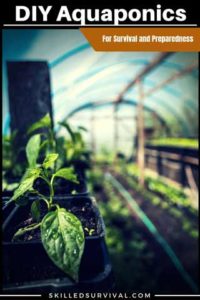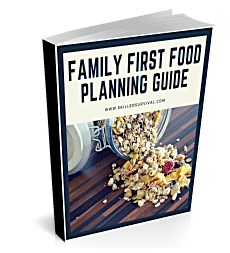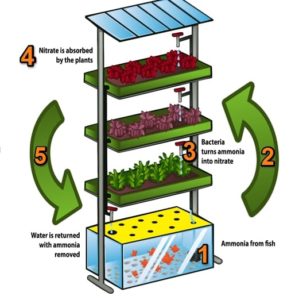
A Complete Guide To DIY Aquaponics For Backyard Food Production
Because it’s the smartest way to grow food per square foot.
It’s the answer to your self-sufficient food production needs.
But most people have never heard of aquaponics – which is a shame.
This guide will get you up to speed on the basics and how to build your own DIY Aquaponics system from scratch:
TOPICS IN THIS GUIDE… ↓(click to jump)
- Self Sufficient Food Production
- What Is Aquaponics Anyway?
- Why Choose Aquaponics
- Science Behind Aquaponics
- How To Plan Your First System
- How To Build Aquaponics
- Aquaponics To The Next Level

Want a free family-first food planning guide?
Click here to instantly download this Complete Checklist PDF. No purchase necessary.Self Sufficient Food Production
As a survivalist, I’ll occasionally catch myself dreaming of food self-sufficiency.
I’ll close my eyes and imagine a large farm.
One with a variety of livestock and a sprawling vegetable garden.
Of course, I spot a few deer and ducks since wild game is great for variety!
Such a system would make me extremely resilient to the uncertain future!
But such an elaborate setup requires a LOT of real estate.
Depending on where you live, it can also be expensive.
Sure, a half-acre “urban farm” can produce a lot of food, but they’re hard to find.
Not to mention the time investment.
Maintenance of such an operation is a commitment few people can manage.
So, is food sufficiency just a survivalist pipe dream?
Could I produce enough calories to survive with the space of a backyard?
Sure you can, with an aquaponics system!
↓ Aquaponics Design – 3 Easiest System Builds For The Backyard
What Is Aquaponics Anyway?
Aquaponics is slightly different from aeroponics or hydroponics…
Aquaponics is a combination and interdependence of two ecosystems:
- Aquaculture (raising fish and other seafood)
- Hydroponics (growing vegetables and other plants in a soil-free system)
Aquaponics is a nearly closed ecosystem.
One where fish and plants are mutually beneficial to each other.
The plants use fish waste as nutrients, while the plants remove the fish waste from the water.
So the fish feed the plants, and the plants filter the toxins from the water.
When in balance, the amount of fish waste produced is offset by the plant’s ability to use it.
Here’s a simple overview of this system in action:
- 1 – Ammonia Is Added To Water Via Fish Wastes
- 2 – Water With Ammonia Is Pumped To Plant/Bacteria Containers
- 3 – Bacteria Converts Ammonia Into Nitrifying Bacteria (plant food).
- 4 – Nitrate Is Absorbed By The Plants
- 5 – A Clean Water Flow Is Returned To The Fish Tank
And here’s an excellent overview video to introduce you to aquaponics and its exciting possibilities:
↓ Backyard Aquaponics: DIY System To Farm Fish With Vegetables

Want a free family-first food planning guide?
Click here to instantly download this Complete Checklist PDF. No purchase necessary.Why You Should Choose Aquaponics
First off, using aquaponics means eliminating the need for unnatural chemical fertilizers.
You also can avoid the complexities of compost management.
Why? Because it’s soil-free farming.
This can be a game-changer if you have poor or contaminated soil.
This means you get fewer weeds in an aquaponics
Aquaponics is efficient.
It’s the best way to produce lots of food in a small footprint.
And it’s expandable.
Making it perfect for growing more self-sufficient over time.
The simplest aquaponic systems grow plants above the fish on floating mats.
This means you only need space for a small fish tank and a limited amount of pumps or plumbing to get started.
Such a compact setup makes home aquaponics ideal.
Heck, I’ve seen family-sized systems on backyard decks and apartment roofs.
Or, with an indoor light source, you can set one up inside, away from the weather, pests, and prying eyes.
Finally, aquaponic systems produce both nutritious vegetables and protein.
The perfect combination for a basic meal.
This is hard to do with a hydroponic system.
Why? Because most vegetable proteins (i.e., beans) need a lot of nutrients and space.
With aquaponics, the fish are your source of protein.
And as we all know, fish is one of the healthiest protein sources.
The bottom line is:
Aquaponics is the most space-efficient way to generate healthy calories to support you and your family today or in a food crisis.
The Basic Science Behind Aquaponics
Before venturing too far into the aquaponics setup, let’s take a second to review the basic chemistry.
Fish release ammonia as a waste product.
It comes from their gills and fish poop.
In a closed system, this ammonia will build to toxic levels if it’s not removed.
And the more fish you have, the faster this build-up occurs.
But aquaponics puts this natural “toxicity” to good use.
It turns ammonia into plant food using two types of bacteria.
Both in the form of biological filtration systems.
The first bacteria (Nitrosomonas) consumes ammonia and releases nitrite.
Following that, a second bacteria (Nitrobacteria) converts the nitrite to nitrate.
Finally, plants use nitrates as their primary nutrient.
This process cleans the water and keeps it healthy for the fish.
Simple but effective.

Want a free family-first food planning guide?
Click here to instantly download this Complete Checklist PDF. No purchase necessary.How To Plan Your First Aquaponics System
Before you begin ordering supplies, you need to know the scale.
One of the benefits of aquaponics systems is they are easily scalable.
If you find yourself short on fish or vegetables, you can add another tank or increase the size of your current one.
You can even harvest an entire tank setup if you’re overrun with food.
Freeze or can the surplus produce and scale down your system accordingly.
This is why IBC (intermediate bulk containers) are popular tanks for aquaponics.
These are easy to find and often have plumbing fittings already in place.
The standard shape is a simple cube design.
It also has an integrated pallet base, making the system sturdy and easier to move than other tanks.
Here’s a video of an IBC – chop and flip aquaponics build:
↓ How To Build An Aquaponic System – Chop & Flip IBC Build
For beginners, you can (and should) start small with a single tank or even a bathtub.
↓ Bathtub Aquaponic System Expanded
The Supplies
A fish tank is the first thing you need to build an at-home aquaponics system.
Any size will do, from small bedroom aquariums to dedicated fish ponds.
And with the natural plant water filter, you can stock fish at a higher density than normal.
But again, I recommend starting with a single IBC container.
Note: if you want an all-in-one bundle for your home aquaponics system, check out this Ecolife ECO-Cycle Aquaponics Indoor Garden System.
Besides the fish tank, you’ll also need a vegetable growth container.
These containers are not as large as the fish tank, but they must be sturdy.
Why? Because they’ll need to hold the accumulating weight of the growing plants and produce.
A wide, shallow container is ideal because plants don’t need deep roots for this setup.
Finally, you’ll need some plumbing supplies (like pvc pipe and a pump).
This moves the water from the fish tank to the plant container.
Now, the best designs take advantage of gravity.
You can do this by placing the plant tank above the fish tank.
This allows the natural drainage of the cleaned plant water to fall back to the fish tank.
It’s best to size the pump for a quick transfer, flooding the plant tank.
Then turn the pump off and allow the water to drain back into the fish tank slowly.
This ensures the roots get watered often but avoid rot.
You don’t want roots continuously submerged.
A
But it is overkill for all but the very smallest systems.
Unless your system is massive, then you’ll want to look at industrial-sized pumps.
You’ll also need a timer for the pump.
This allows you to schedule several cycles per day automatically.
You’ll also need separate growing media for plants and bacteria.
Unlike traditional gardening, this setup doesn’t use soil.
Remember, the plants will receive their nutrients from fish waste.
So their growing media should be something durable and inert – soil is neither of these.
Look for a quick-draining material such as gravel, coarse sand, or even coconut fiber.
Expanded clay balls are also a common growing medium, though they’re more expensive.
Check out this video for even more information about choosing the right growing media for you:
↓ How To Setup Aquaponic Grow Bed & Select The Right Rock
As for the bacteria, look to aquarium filter media or filter fiber.
These provide enough water movement and a large enough surface area.
Both of which are necessary for a bacterial colony to thrive.
↓ Water Quality Issues In Aquaponic Systems
Which Fish and Plants?
Finally, you’ll need to get the organic components of your system – the fish, plants, and bacteria.
Bacteria is straightforward – it’s the same variety for all water temperatures.
But the choice of plant and fish is temperature dependent.
They must be hardy enough to tolerate the environmental conditions (i.e., the temperature swings).
So keep in mind the temperatures at which the plants and fish will live year-round.
This is especially true if you plan an outdoor system in winter climates.
Here are some basic water temperature guidelines for fish and plant selection:
Warm Water Tanks
With warm water tanks, choose a fish species that can survive on low amounts of dissolved oxygen.
Tilapia, channel catfish, and yellow perch are good options.
Tilapia has the added benefit of quick reproduction and mild flavor.
Channel catfish also have rapid growth characteristics. But you must remove their scale-free skin before cooking – which is a pain.
And they don’t tolerate excessive handling very well.
Yellow perch are aggressive feeders and reproduce fast as well.
They also taste great and are easy for beginners to manage.
With warm water systems, consider leafy warm-weather greens.
Varieties such as lettuce, peas, and basil are best.
These vegetables all do well with warm water tanks and produce a quick harvest.
Cold Water Tanks
In colder water, many of the same fish species will work.
But perch is temperature tolerant, as are channel catfish.
Trout are best left for more established aquaponics systems.
They are ideal once you’ve mastered a stable, highly oxygenated water system.
That’s because trout are more sensitive to water chemistry fluctuations.
Alongside cold-water fish, thick leafy vegetables are best.
Kale, spinach, bok choy, and Swiss chard all tolerate or thrive in colder climates.
Here’s an excellent overview video on different fish species for aquaponics systems.
Worth a watch to help decide on the best fish species for you:
↓ The BEST Fish For Aquaponics?
↓ What Are The Best Fish For Aquaponics?

Want a free family-first food planning guide?
Click here to instantly download this Complete Checklist PDF. No purchase necessary.How To Build An Aquaponics System
After you’ve planned your system, it can be tempting to buy everything at once and get started.
But that’s a recipe for disaster.
Make sure to bring the system online slowly in a step-by-step fashion.
This takes time to get everything up to speed.
So instead, follow these simple steps.
That way, you’ll increase your odds of establishing a healthy, productive aquaponics system.
1. Location
Choose your location with care. You don’t want to disturb your system once you’re up and running.
Even smaller systems are difficult to move without completely disassembling.
And moving adds stress to plants, fish, and bacteria.
Look for an area with plenty of light (unless you plan to use artificial grow lights).
If your location has strong sun and high temps, use a shade screen to reduce excessive water heating.
You’ll also want adequate access for cleaning. And remember, water is also heavy.
So be sure you have a stable surface to build on, or you may find things shifting or sinking on you.
Leaks or failure of tanks could cause damage to the surroundings as well as a total loss of the system.
2. Setting up Tanks and Pumps
Once you have your location, it’s time to set up your tanks, pumps, and plumbing.
Most aquaponics systems use gravitational drainage from the plant to the fish tank.
This means setting up the plant tanks at a higher elevation.
But that can take the form of high benches, shelves, or even a hillside.
Be creative and use what works best.
Just make sure your pump can handle pumping water up the difference in elevation (referred to as “head”).
While you set up the pump and plumbing, check for any leaks at all the fittings.
Finally, add an air pump and stone to the fish tank to provide dissolved oxygen.
With all the leaks managed, you can put in the growing media and finish filling the water to the right level.
If your water is chlorinated, allow ample time for it to dissipate.
It is harmful to your system.
So do this before introducing your bacteria, fish, or plants.
You can speed the process up by circulating the water through the system.
At the same time, go ahead and turn on the air pump and allow it to run full-time.
This aeration of the water helps the chlorine escape and introduces dissolved oxygen.
Allow this to run for several days to ensure the chlorine is all removed.
One popular way to control the level of water in the grow bed is with a bell siphon.
Check out this video to learn how these work and how to build your own:
↓ How To Make A Bell Siphon & How They Work
3. Cycling The System
At this point, you can introduce the plants and bacteria to the system, but not fish.
Both species of bacteria are present throughout the environment.
But it can be helpful to get a starter to help establish the colony.
Most aquarium shops can provide you with more than enough to get going.
You can get a source of pure ammonia in the laundry aisle at the grocery store to get your colony to grow.
At this point, you’ll need some basic water testing supplies.
These allow you to determine if the ammonia is being converted to nitrite and then nitrate.
If you successfully convert all the way to nitrate, you can add your plants.
Then allow the system to run for a while before introducing fish.
This phase is when the bacteria convert ammonia to plant food. And the plants clean the water.
This helps reduce the fish’s shock due to any changes in water chemistry.
4. Adding Fish
Finally, once you have a colony of bacteria and your water parameters are stable, you can add fish.
But add them slowly, allowing them to acclimate to the temperature and chemistry of the water.
Never dump fish into a new tank haphazardly; the abrupt change can shock or even kill them.
Ask your fish supplier for suggestions on how best to acclimate your chosen species.
5. Maintaining The System
Once your aquaponics system is running, there’s not a lot of ongoing maintenance required.
Sure, the fish will need food.
You’ll need to test water chemistry on occasion.
But one of the best system health indicators is growing plants and healthy fish.
If you’re still reading this article, I know you’re serious about building your own aquaponics system.
That’s why you should consider investing in a real educational product.
Click here to check out his quality aquaponics build series.
A product like this helps you succeed immediately and, more importantly, avoid major pitfalls.
Taking Your Aquaponics To The Next Level
If you’re looking to be self-sufficient without the farm, take a good hard look at aquaponics.
Aquaponics can produce a continuous stream of fresh vegetables and healthy fish.
In a small-scale backyard system that’s efficient in both time and resources.
You can build them at any scale you want, from feeding a single person to an entire community.
And there are ways to remove or eliminate the inputs and expand the outs!
Watch the following Ted Talk and get an idea of how this works:
↓ TEDxWarwick – Aquaponics – Getting More Out Of Less
Why Trust Skilled Survival...
Go here now to review a full breakdown of:
- Who We Are
- Our Credentials
- Our Mission
- & Product Recommendations...
Here are a few highlights of our teams credentials & certifications:
- Certified Member of a Mountain Search & Rescue Organization
- Plant Emergency & Safety Leader for a Major Food Manufacturer
- Member of the 10TH Mountain Division Hut Association
- Certifications: Avalanche 1, WFR, CPR
- Official Gear Tester for Numerous Outdoor Gear Companies
- Countless Multiday Backpacking trips into Remote Wilderness
- Bachelor's Degree In Mechanical Engineering
- Bachelor's Degree In Civil Engineering
- Bachelor's Degree In Biomedical Engineering
"It takes 20 years to build a reputation and five minutes to ruin it." - Warren Buffett
We're fully aware that TRUST is NOT something you GET but is EARNED.
And we'll continue to earn YOUR trust through our forthright and honest approach with each new Blog Post, Guide & Product we create...
Jason K.
P.s. Do You Live In A 'Danger Zone' County?

Find out now using my Danger Zone County List & Special Report it’s absolutely FREE.
In minutes you’ll know EXACTLY where you stand and if you should be worried or not..
So click here to get my FREE Danger Zone County List & Report…

Recommended Reading
Emergency Food Storage When Calories Become Scarce
Building your emergency food storage doesn't have to be complicated. We break things down into simple steps to help you do it right.
The Most Nutritious Survival Foods You’ll Actually Love
What are the best survival foods? It depends on your goals. We look at different scenarios to help you stockpile the best emergency foods.
Dehydrating Fruit: How To Preserve Sweet Calories
Dehydrating fruit is a great way to store tasty calories for long-term storage. We should you the best way to dehydrate some for emergencies.
Unique Food Storage Ideas: The Most Surprising Locations
Want a large emergency food stockpile but living in cramped quarters? Don't let this ruin your preparedness passion! Try these unique food storage ideas.
Best Prepper Foods To Stockpile For Food Storages
What's the worst-case scenario if you choose NOT to stockpile any food? Starvation. That's why prepper foods are such a wise investment.
Valley Food Storage Review: An Expert Puts It To The Test
Unbiased and thorough Valley Food Storage review covering food supplies, packaging, taste, and shelf life. Don't buy without reading this...


